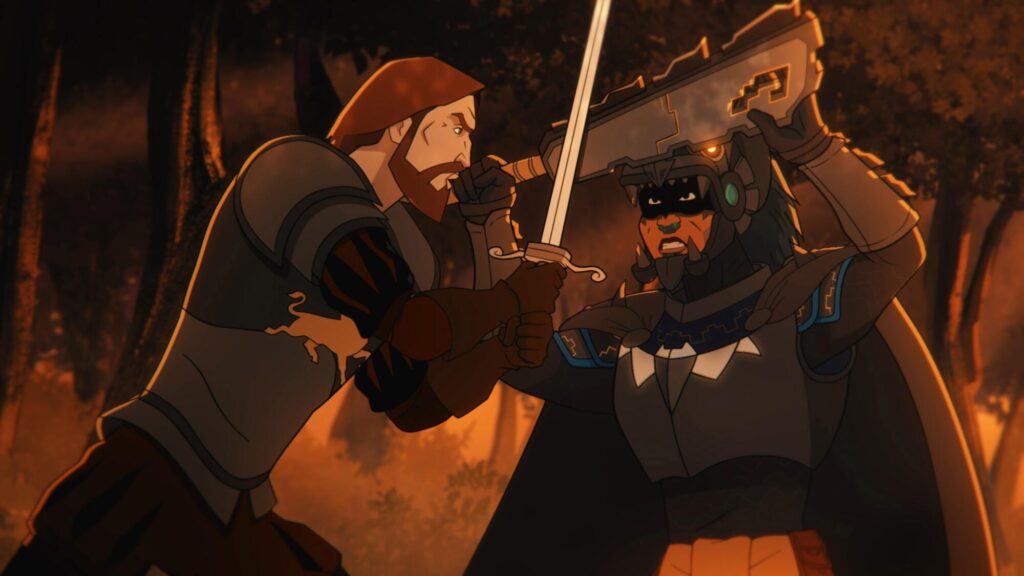Though the new animated feature “Aztec Batman: Clash of Empires” bears the name of one the most emblematic American superheroes, its creation was entirely a Mexican affair.
The action-packed saga reimagines the caped crusader as a young Aztec man named Yohualli, whose father is killed when conquistador Hernan Cortes arrives on the coast of what we know today as the state of Veracruz. By the time Cortes and his troops reach the Aztec capital of Tenochtitlan, the brave Yohualli has become a fierce warrior protected by the bat deity known as Tzinacan (an actual Aztec god that fits perfectly within this fictional narrative).
Produced by Mexico City-based animated outfit Ánima Estudios, a company at the forefront of the medium in the country for over two decades, “Aztec Batman” emerged as an attempt to expand Ánima’s relationship with Warner Bros. Ánima previously produced two CG-animated films based on “Top Cat,” the classic Hanna-Barbera cartoon owned by Warner.
Released Sept. 18 on HBO Max, “Aztec Batman” was initially conceived as a miniseries, and eventually took the more concise form of a film. And while it’s a work meant to entertain, the creators hope that it also ignites new curiosity in younger audiences, particularly those in Mexico and of Mexican descent elsewhere, to learn more about Indigenous peoples.
“The movie seeks to generate pride because part of our roots as Mexicans are Indigenous cultures,” Ánima co-founder José C. Garcia de Letona said in Spanish during a recent video interview. “For many of us, the other part comes from the Spanish. We’re not passing judgment because we are a consequence of what happened, but rather giving a slightly more respectful place to the Aztecs and all Indigenous cultures.”
Why focus on the Aztecs out of the numerous civilizations that existed in the territory that now constitutes Mexico? “Because they were the ones who confronted the Spanish. As the name suggests, it was a clash of empires,” Garcia de Letona adds.
“The victors usually decide who the good guys and the bad guys were when they write their version of the story, but they always omit or diminish the other side. And this is an opportunity to tell this chapter of history from a perspective that isn’t often told,” explains director Juan Meza-Leon, a native of Ensenada, in the Mexican state of Baja California Norte, who has worked in the U.S. animation industry since the mid-2000s. While Meza-Leon has a story credit, Ernie Altbacker, a veteran in the world of DC Comics, wrote the screenplay.
Key to the aesthetic and historical authenticity of “Aztec Batman” was the knowledge that Alejandro Díaz Barriga, one of the most prominent historians of Aztec culture, shared with the production.
“Alejandro accompanied us from the script stage to the character design up to the final cut of the film,” explains Garcia de Letona. Díaz Barriga’s contributions included details on how clothing differed depending on the person’s social class, and letting the production know that the Aztecs didn’t have chairs, tables or doors in their daily lives.
The armor for this Batman took inspiration from Aztec eagle warriors and jaguar warriors, and integrated elements referencing the god Tzinacan. For example, the Batman insignia in the film is at once recognizable as an Aztec design, while also instantly identifiable as the superhero’s logo. “We wanted the designs to have that pre-Columbian quality, but at the same time to look appropriate for what they are: comic book characters,” says Meza-Leon.
The animation team behind “Aztec Batman” consisted mostly of Mexican talent with a few other artists in Brazil and Peru. “Many of us in Latin America, myself included, never imagined being part of a Batman project, and that excited us all infinitely,” says Garcia de Letona.
From the onset, Warner insisted “Aztec Batman” should be produced in Spanish first, and then dubbed into English. The Spanish cast includes actors Horacio Garcia Rojas and Omar Chaparro, while the English version features Mexican American actors Jay Hernandez and Raymond Cruz. U.S.-based Mexican filmmaker Jorge Gutierrez (“The Book of Life”) voices Yohualli’s father, Toltecatzin, in both versions.
Whether you watch with the original Spanish track or the English dub, the dialogue is laced with phrases and words in the Nahuatl language, the native tongue of the Aztecs. “Once the story was finalized, we collaborated with a Mexican writer named Alfredo Mendoza, who helped us incorporate the Nahuatl language to differentiate between the different empires since they both speak Spanish in the film,” said Meza-Leon.
Batman’s classic villains are also transformed into characters that exist organically within the Aztec context. The Joker, for example, becomes Yoka, a shaman and right-hand man to emperor Moctezuma who can communicate with the gods. Catwoman appears here as a jaguar warrior, since there were no domestic cats at that point in history in the Americas. Some creative liberties were taken — the Aztec wouldn’t allow women to become trained fighters. The dubious Cortes becomes Two-Face, while Poison Ivy appears as an enigmatic goddess.
“The idea wasn’t to make a copy of the characters, but to capture their essence, so you could say, ‘That’s the Joker,’ ‘That’s Two-Face,’ ‘That’s Catwoman,’ although we never called them by those names,” says Meza-Leon. “We also never call him Batman; it’s Tzinacan or Bat Warrior, but the spirit of the character is there.”
Since the project was originally developed as a series, Meza-Leon has already developed a larger world. If this first chapter succeeds with audiences, an “Aztec Batman” sequel is feasible. The film is currently playing in Mexican cinemas and streaming globally. “I hope it is successful enough for us to continue exploring this alternative version of the conquest of Mexico, because there are still many ideas left,” says Meza-Leon.
